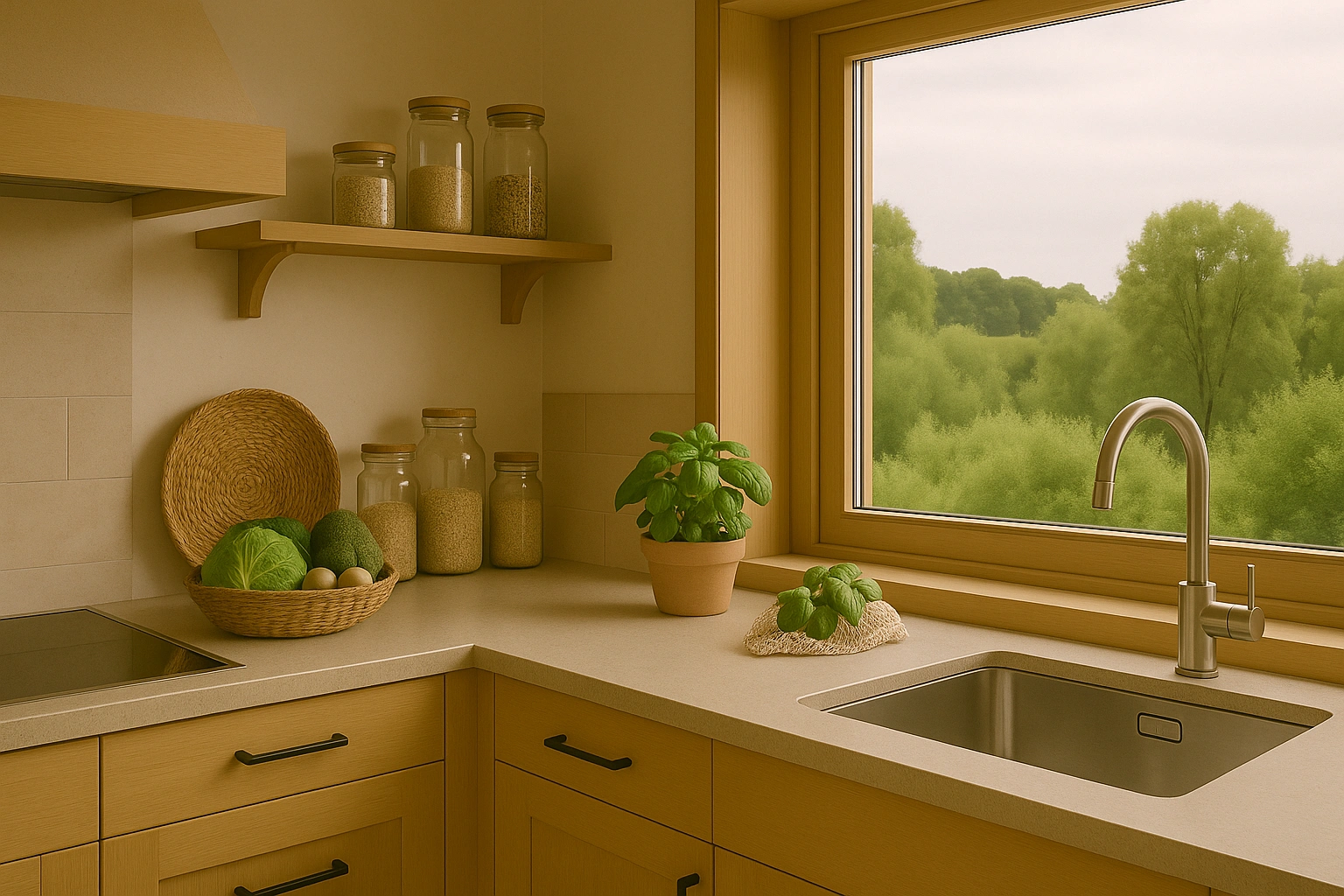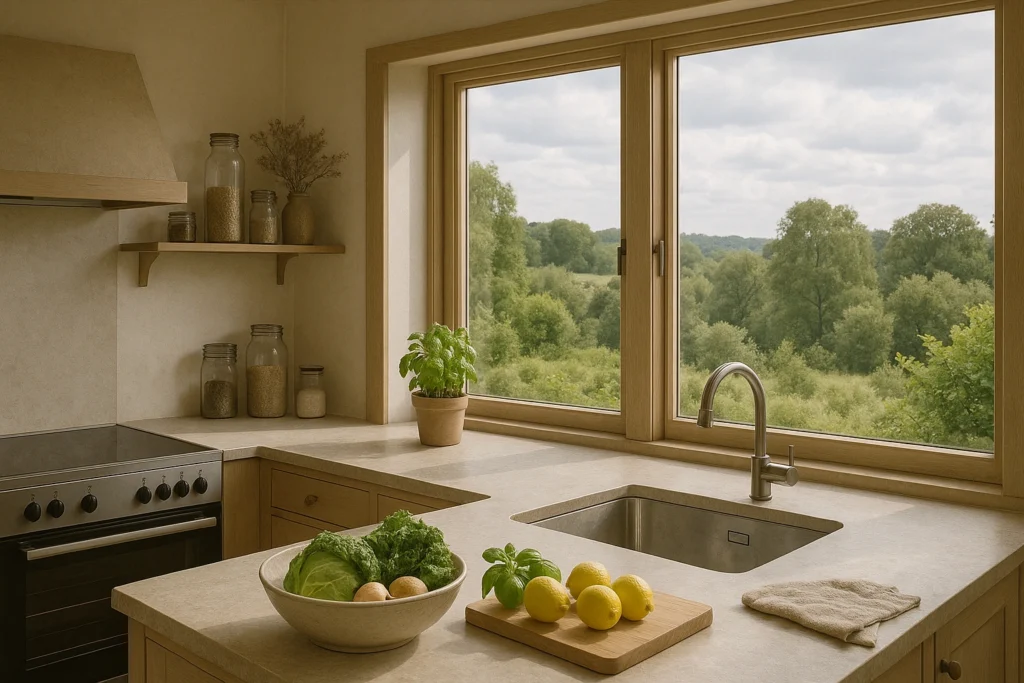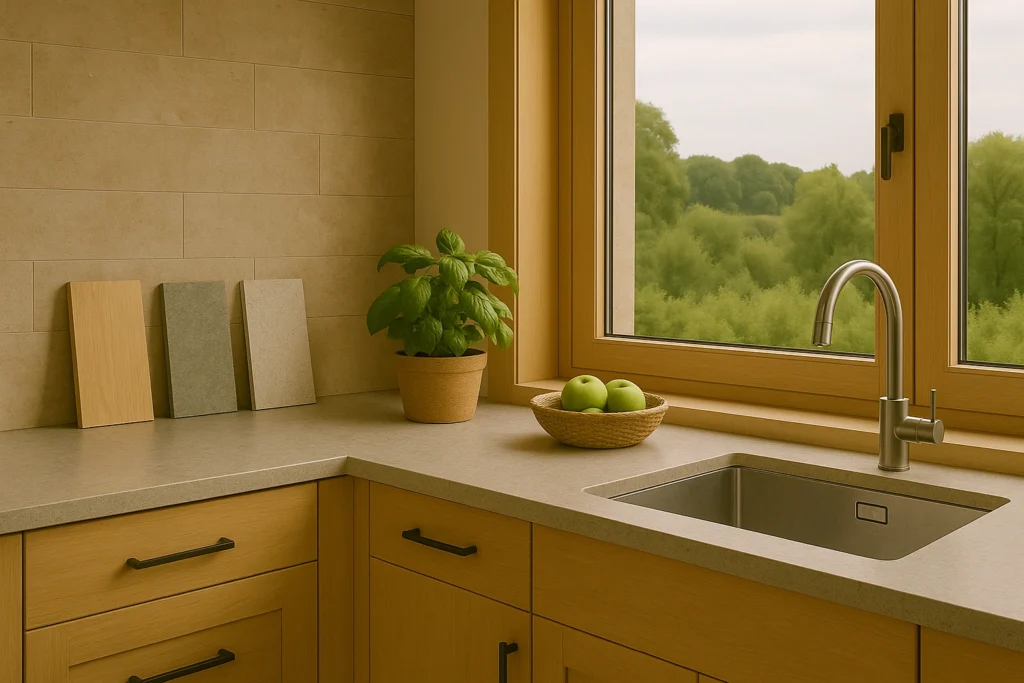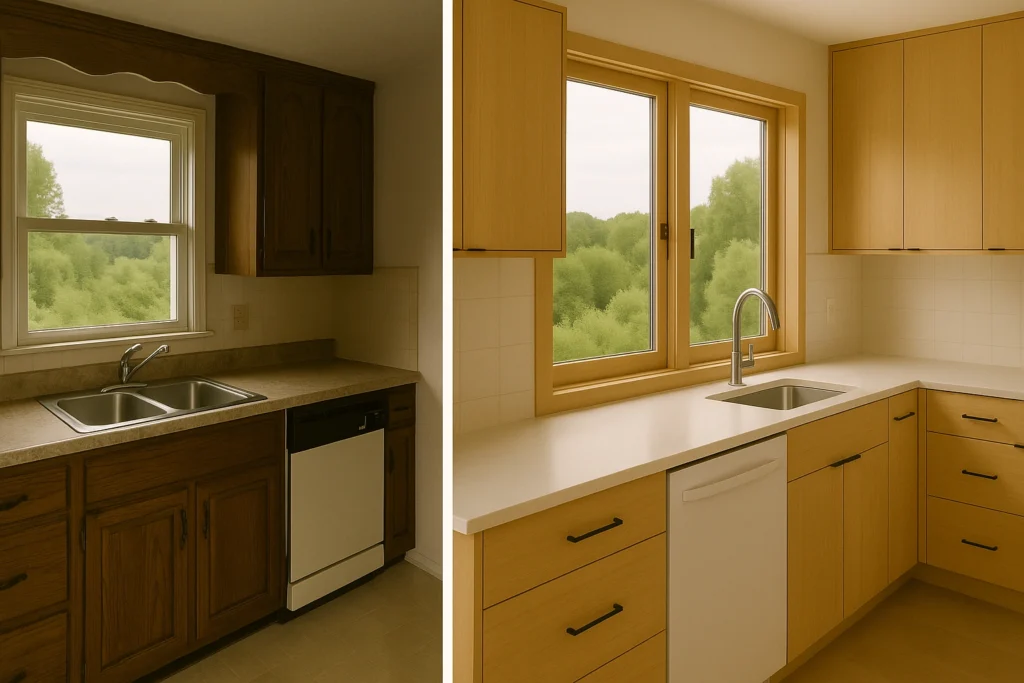The Rise of Eco-Friendly Kitchens: Sustainable Choices That Last

The thing is, most people don’t know where to start with green changes. This guide shows you the simple steps to create an eco-friendly space that saves money and protects the planet. You’ll learn which green upgrades help your electricity bill and your home’s value. Plus, sustainable kitchen choices often pay for themselves with lower utility costs.
Here’s what I love about this topic. At Sweet Lydia’s Kitchen, I get to see families light up when their new green kitchen starts cutting their monthly bills. Honestly, there’s nothing like watching someone learn that their beautiful new space saves them money every month.
What Makes a Kitchen Truly Sustainable?
A truly sustainable kitchen uses energy-efficient appliances, water-saving fixtures, and good materials that help the environment while cutting your bills. Let’s be honest here, the word “green” gets used a lot in kitchen design. Real green kitchens use less stuff and make less waste over time.

Here’s what makes a kitchen truly eco-friendly:
- Smart Resource Management: Your appliances should use less electricity and water than regular models. The reason is simple. When your kitchen uses less, you save money and help the environment. Your cabinets, countertops, and flooring should use good materials like reclaimed wood or bamboo instead of cutting down new trees.
- High-Performance Equipment: Look for energy-efficient kitchen appliances that have good ratings. My client Sarah got a new refrigerator that uses way less electricity than her old one, which dropped her monthly bill by $25. That’s $300 back in her pocket every year. When you think about water savings, features in dishwashers and faucets also help cut your water use.
- Sustainable Material Selection: Green cabinets made from good materials last longer and look better than cheap ones. When you pick countertops from recycled stuff, you help reduce waste and get nice surfaces. These materials work great in busy kitchens because they handle heat, spills, and daily use better than cheaper options.
(And yes, I’ve seen that greenwashing circus before, where companies put “eco-friendly” labels on regular products just to charge more.)
Energy Efficient Appliances That Actually Save Money
What if your kitchen appliances could pay for themselves through energy savings alone? This sounds too good to be true, but it happens all the time with the right energy-efficient appliances. Let’s look at the three types that cut your electricity bill the most.
Refrigerators with Smart Features
The newer refrigerators with smart sensors have changed how I think about kitchen cooling. I clearly remember my client Maria calling me about her new smart fridge. She was shocked because it cut her monthly electricity bill by $40 just by watching her family’s habits.
The sensors noticed she opened the door most often during morning coffee prep and dinner time. So the fridge learned to pre-cool before those busy times and relax during quiet hours. This smart timing saves electricity without hurting food freshness.
Induction Cooktops
You know how gas cooktops waste heat by warming up your whole kitchen? Induction cooktops are different because they only heat the pan itself. I love cooking with induction because water boils in half the time of my old electric range.
The surface stays cool enough to touch even while cooking, which means less AC running during hot weather. One homeowner told me she loves cooking big family meals now because her kitchen doesn’t feel like an oven anymore. Her family spends more time in the kitchen during the summer months.
Energy Saving Dishwashers and Lighting
Look for ENERGY STAR appliances that meet strict rules set by the U.S. EPA. Careful thought about these ratings is important because rated appliances use way less electricity and water than regular models. The newer dishwashers are smart enough to test how dirty your plates are before starting the wash cycle.
Speaking of smart upgrades, LED lighting under cabinets gives you bright light that uses way less electricity than those old bulbs. Your workspace gets brighter while your electricity bill gets smaller. It’s one of those changes that makes you wonder why you waited so long.
From my experience designing kitchens, I think about how much families cook before planning the layout, and energy-efficient appliances become even more important for families who cook daily.
Choosing Materials for Your Green Kitchen
You know what I love about green materials? They last way longer than the cheap stuff. I’ve seen too many kitchens where “budget-friendly” cabinets start peeling after eight months.

Here’s the thing about sustainable options. Green cabinets made from bamboo or reclaimed wood tell a story while helping forests stay healthy. Bamboo grows back in just 3 to 5 years compared to 25 to 50 years for regular trees.
The beauty of these materials is that they fit any style you want. I’ve designed modern kitchens with sleek bamboo cabinets and traditional ones with reclaimed wood that looks like it came from an old farmhouse. No matter what look you’re going for, whether it’s contemporary, eclectic, or something totally different, these materials adapt perfectly.
Take reclaimed wood, for example. It brings history into your kitchen with unique marks and patterns you can’t get from new lumber. Some families find old barn wood that still has original nail holes from the 1800s. (Because who hasn’t dealt with that “eco-friendly” cabinet that falls apart after six months?)
Popular green materials include:
- Bamboo cabinets
- Reclaimed wood
- Recycled glass countertops
- Butcher block countertops
- Low VOC paints
- Stainless steel fixtures
- Cork flooring
Moving on to surfaces, your countertops offer another chance to go green. Recycled glass countertops use old bottles that would otherwise sit in landfills, which gives them character you won’t find in regular stone. These surfaces handle stains better than natural options and come in amazing colors.
For a warmer feel, butcher block countertops from good wood sources add natural beauty to any kitchen. They’re also easy on your knives and can be sanded down if they get scratched over time.
Planning Your Eco-Friendly Kitchen Remodel
Planning a green remodel is the fastest way to avoid costly mistakes and make sure every dollar you spend helps both your wallet and the environment. You might be wondering where to even start with all these eco-friendly options. What I’ve learned is to take it one step at a time instead of getting overwhelmed by everything.
Step 1: Check Your Current Energy Use
Start by looking at your current energy bills to see where you’re losing the most money. Your fridge might be from 2005 and is eating up $50 a month in electricity. Old lighting can be another huge drain on your budget.
Write down which appliances use the most power so you know what to tackle first. This simple step saves you from guessing and helps you focus on changes that actually matter.
Step 2: Set Your Budget and Timeline
Figure out how much you can spend on your kitchen remodel without going broke. I’ve seen families try to do everything at once and end up eating takeout for six months.
Break your project into chunks so you can spread costs over time. Maybe start with new energy-efficient appliances this season and save green cabinets for next year. Your kitchen stays usable this way.
Step 3: Find the Right Help
Work with contractors who understand green building practices and local codes. The problem is not every contractor knows about sustainable materials or energy rebates. That’s why you need to ask them specific questions about eco-friendly options before you hire anyone.
Step 4: Plan Your Layout Smart
Think about how your family uses the kitchen every day. I work with families to decide on layout and help them choose elements that work perfectly with their design concept, which becomes even more important when planning sustainable upgrades.
Smart planning makes your new sustainable kitchen work better for how you cook and live. You don’t want gorgeous green cabinets that make grabbing a snack feel like an obstacle course.
Step 5: Order Materials Early
The thing about sustainable materials like reclaimed wood is that they often take longer to get than regular options. Once you know what you want, order your cabinetry and special materials early so your project stays on track. This planning step saves you major headaches later.
Pro Tip: Always order 10% extra sustainable materials since they can be harder to match if you need more. Keep leftover pieces for future repairs.
Real Kitchen Renovations: Before and After Success Stories
You want to see what happens when families actually go green with their kitchens? The transformations I’ve seen over the years show real improvements in both comfort and costs. Green kitchen renovations typically deliver savings that homeowners notice right away.

And that’s where things get interesting. Families who start with small changes like LED lighting and energy-efficient appliances often come back for bigger upgrades. Once they see their electricity bills drop, they want even more savings.
The most common pattern I see is people starting with appliance upgrades first. New refrigerators and dishwashers with good energy ratings can bring a change in monthly bills for sure. Then they move on to lighting changes and eventually tackle projects like green cabinets.
When families go all out with full green remodels, the results are amazing. Modern kitchens with sustainable materials like bamboo cabinets and recycled glass countertops not only save energy but also feel different. The whole space becomes a place where you actually want to spend time.
You know what surprises people the most? It’s the little things that make a real impact on daily life. Your new LED lighting makes chopping vegetables so much easier because you can actually see what you’re doing. Those energy-efficient appliances don’t hum and rattle like your old ones did. The green materials I use often feel more solid and look more expensive than the cheap stuff they replace.
(And I’ve tracked these types of improvements over years of kitchen projects, so I know the patterns are consistent.)
Ready to Start Your Green Kitchen Journey?
Now that you understand the components of sustainable kitchen design, you’re ready to take the first step toward creating your own eco-friendly space. I’m talking about energy audits that show you exactly where your money goes every month. These audits reveal which changes will save you the most, so you don’t waste time on upgrades that won’t help your bills.
You might be surprised at how much help is available for green kitchen projects. Local rebates and incentives can cut thousands off your appliance costs. Your utility company probably has programs you don’t even know about yet.
Ready to make your kitchen both beautiful and sustainable? Contact Sweet Lydia’s Kitchen today, and let’s design a space that saves you money every month while helping the environment.
FAQs
Got questions about green kitchens? These are the ones I hear most often from homeowners.
How much can I save with energy-efficient kitchen appliances?
Most families save $30-80 monthly on electricity bills with energy-efficient appliances. The exact amount depends on how old your current appliances are and how much you cook. Refrigerators and dishwashers usually give you the most savings.
Which green materials last longest in busy kitchens?
Bamboo cabinets and recycled glass countertops handle daily use better than most traditional materials. Stainless steel fixtures also last for decades with proper care. These materials actually get better with age instead of falling apart.
Do eco-friendly renovations increase home resale value?
Yes, green kitchens typically add more value because buyers love lower utility costs. Energy-efficient appliances and sustainable materials are selling points that make your home stand out. Most buyers are willing to pay more for a kitchen that saves them money every month.